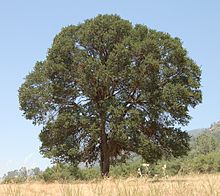Quercus douglasii
| Blue oak | |
|---|---|
 |
|
| A large blue oak in a pasture in Mariposa County, California. | |
| Scientific classification | |
| Kingdom: | Plantae |
| (unranked): | Angiosperms |
| (unranked): | Eudicots |
| (unranked): | Rosids |
| Order: | Fagales |
| Family: | Fagaceae |
| Genus: | Quercus |
| Section: | Quercus |
| Species: | Q. douglasii |
| Binomial name | |
|
Quercus douglasii Hook. & Arn. 1840 |
|
 |
|
| Natural range | |
| Synonyms | |
|
|
Quercus douglasii, known as blue oak, is a species of oak endemic to (found only in) California, common in the Coast Ranges and foothills of the Sierra Nevada. It is occasionally known as mountain oak and iron oak.
Quercus douglasii is a medium-sized tree, generally 6–20 m (20–66 ft) tall, with a trunk 36–60 cm (1–2 ft) in DBH. The tallest recorded specimen was found in Alameda County, at 28.7 m (94 ft). The bark is light gray with many medium-sized dark cracks; from a distance, it can appear almost white. The name blue oak derives from the dark blue-green tint of its leaves, which are deciduous, 4–10 cm (1.6–3.9 in) long, and entire or shallowly lobed. The acorns are 2–3 cm (0.8–1.2 in) long, with a moderately sweet kernel, and mature in 6–7 months from pollination.
Quercus douglasii prefers dry soil and plenty of sunlight. It is the most drought tolerant of California's deciduous oaks.
Quercus douglasii often co-habitates with gray pine (Pinus sabiniana), and is also found with interior live oak (Q. wislizeni), valley oak (Q. lobata), Oregon white oak (Q. garryana),canyon live oak (Q. chrysolepis), and Pacific madrone (Arbutus menziesii). Natural hybrids between Q. douglasii and the related shrub live oak (Q. turbinella), Q. lobata, and Q. garryana often occur where the species grow together in the same area.
...
Wikipedia
